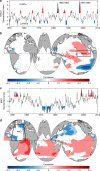A recent increase in global wave power as a consequence of oceanic warming
- PMID: 30643133
- PMCID: PMC6331560
- DOI: 10.1038/s41467-018-08066-0
A recent increase in global wave power as a consequence of oceanic warming
Abstract
Wind-generated ocean waves drive important coastal processes that determine flooding and erosion. Ocean warming has been one factor affecting waves globally. Most studies have focused on studying parameters such as wave heights, but a systematic, global and long-term signal of climate change in global wave behavior remains undetermined. Here we show that the global wave power, which is the transport of the energy transferred from the wind into sea-surface motion, has increased globally (0.4% per year) and by ocean basins since 1948. We also find long-term correlations and statistical dependency with sea surface temperatures, globally and by ocean sub-basins, particularly between the tropical Atlantic temperatures and the wave power in high south latitudes, the most energetic region globally. Results indicate the upper-ocean warming, a consequence of anthropogenic global warming, is changing the global wave climate, making waves stronger. This identifies wave power as a potentially valuable climate change indicator.
Conflict of interest statement
The authors declare no competing interests.
Figures








References
-
- IPCC. Climate Change 2013: The Physical Science Basis. Contribution of Working Group I to the Fifth Assessment Report of the Intergovernmental Panel on Climate Change. (Cambridge University Press, Cambridge, 2013).
-
- Wong, P. P. et al. Coastal systems and low-lying areas. Climate Change 2014: Impacts, Adaptation, and Vulnerability. Part B: Regional Aspects. Contribution of Working Group II to the Fifth Assessment Report of the Intergovernmental Panel on Climate Change. 361–409 (Cambridge University Press, Cambridge, 2014).
-
- Melet A, Meyssignac B, Almar R, Le Cozannet G. Under-estimated wave contribution to coastal sea-level rise. Nat. Clim. Chang. 2018;8:234–239. doi: 10.1038/s41558-018-0088-y. - DOI
-
- Fan Y, Held IM, Lin SJ, Wang XL. Ocean warming effect on surface gravity wave climate change for the end of the twenty-first century. J. Clim. 2013;26:6046–6066. doi: 10.1175/JCLI-D-12-00410.1. - DOI
Publication types
LinkOut - more resources
Full Text Sources

